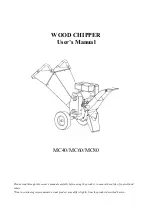
3. Set meter for approximately 20 vdc.
4. Turn power on, but do not enter quick test mode. For the
first 100 seconds, valve motor windings will be alter-
nately energized to close valve in circuit 1.
5. During this time, connect negative test lead to terminals
9, 10, 11, and 12 in succession. Voltage should rise and
fall at each pin. If it remains constant at a voltage or at
0 v, remove connector and recheck. If problem is still there,
replace processor board. If it is no longer there, check
EXV.
6. Turn power off and connect positive lead to terminal 1 on
connector J7.
7. Turn power on. After 100 seconds, motor windings in cir-
cuit 2 valve will begin to be energized.
8. During this time, connect negative test lead to terminals
2, 3, 4, and 5. Voltage should rise and fall at each pin. If
it remains constant at a voltage or at 0 v, remove con-
nector and recheck. If problem is still there, replace pro-
cessor board. If there is no longer a problem there, check
EXV.
Step 2 — Check EXV Wiring — Check wiring to EXVs from
J7 terminal strip on processor board (see Fig. 30).
1. Check color coding and wire connections. Make sure wires
are connected to correct terminals at J7 and EXV plug
connections.
2. Check for continuity and tight connection at all pin
terminals.
3. Check plug connections at J7 and at EXVs. Be sure EXV
connections are not crossed.
Step 3 — Check Resistance of EXV Motor Windings — Re-
move plug at J7 terminal strip and check resistance between
common lead (red wire, terminal D) and remaining leads A,
B, C, and E. Resistance should be 25 ohms ± 2 ohms.
Step 4 — Check Thermistors that Control EXV — Check
thermistors that control processor output voltage pulses to
EXVs. Circuit A thermistors are T5 and T7, and circuit B
thermistors are T6 and T8. Refer to Fig. 21 for location.
1. Use quick test steps 2.0. through 2.3. to determine if ther-
mistors are shorted or open.
2. Check thermistor calibration at a known temperature by
measuring actual resistance and comparing value mea-
sured with values listed in Tables 15 and 16.
3. Make sure that thermistor leads are connected to proper
pin terminals at J1 terminal strip on processor board and
that thermistor probes are located in proper position in
refrigerant circuit (Fig. 21 and 23).
When above checks have been completed, actual opera-
tion of EXV can be checked by using procedures outlined
in Step 5 — Check Operation of the EXV section below.
During quick test steps 3.5. and 3.9., each EXV is opened
approximately 500 steps by processor. This quick test
feature, along with initialization mode
, can be used to
verify proper valve operation.
Step 5 — Check Operation of the EXV — Use following
procedure to check actual operation of EXVs.
1. Close liquid line service valve for circuit to be checked
and run through appropriate quick test step 3.5. or 3.9. to
pump down low side of system. Repeat quick test
step 3 times to ensure all refrigerant has been pumped
from low side and that EXV has been driven fully open
(1500 steps open).
NOTE: Do not use control ON-OFF switch to recycle con-
trol during this step, and be sure to allow compressors to
run full 10 seconds at each step.
2. Turn control circuit switch and compressor circuit break-
er(s) to OFF position. Close compressor service valves
and remove any remaining refrigerant from low side of
system.
3. Remove screws holding top cover of EXV. Carefully re-
move top cover, using caution to avoid damage to the O-ring
seal and motor leads. If EXV plug was disconnected dur-
ing this process, reconnect it after the cover is removed.
4. Note position of lead screw (see Fig. 29). If valve has
responded properly to processor signals in Step 5.1 above,
valve should be fully open and lead screw should pro-
trude approximately
1
⁄
4
in. (6 mm) to
3
⁄
4
in. (19 mm) above
top of motor.
5. Recycle control by turning control circuit switch to ON
position. This puts control in initialization mode
.
During first 100 seconds of initialization mode, each valve
is driven to fully closed position (zero steps open) by pro-
cessor. With cover lifted off EXV valve body, observe
operation of valve motor and lead screw. The motor should
turn in the counterclockwise (CCW) direction and lead
screw should move down into motor hub until valve is
fully closed. Lead screw movement should be smooth and
uniform from fully open to fully closed position.
Fig. 29 — Electronic Expansion Valve (EXV)
EXV — Electronic Expansion Valve
Fig. 30 — Processor Board Connections
62







































